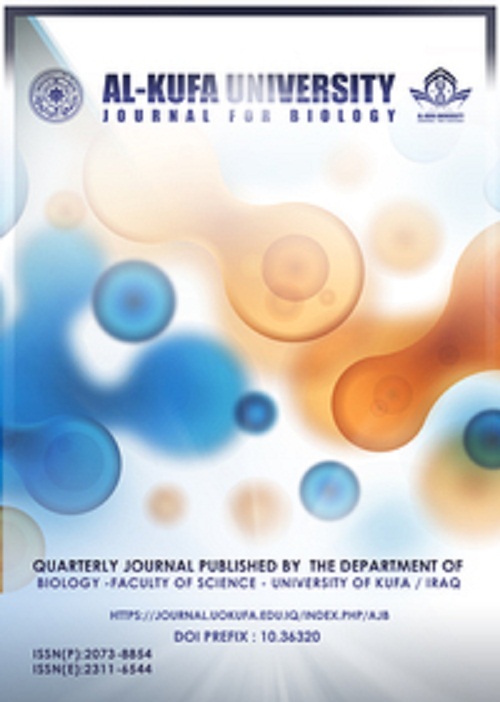Molecular identification of Trichophyton interdigitale from patients with dermatophytosis
DOI:
https://doi.org/10.36320/ajb/v15.i3.13411Keywords:
Trichophyton interdigitale , DNA Sequencing , phylogenetic tree, NCBI, dermatophytosis, Trichophyton mentagrophytesAbstract
Trichophyton interdigitale is a significant pathogen responsible for dermatophytosis, including tinea unguium & tinea pedis.Fungal genome contains numerous copies of ribosomal DNA (rDNA).(ITS) region can be used to analyze relationships between closely related taxa.The genetic variants of the ribosomal sequences were investigated to assess pattern of biological diversity of three different isolates (assigned S4, S6 and S7) collected in Karbala province.Our results indicated the exact identity of the amplified samples. Sequencing reactions indicated that the identity of samples of S4, S6, and S7 was Trichophyton interdigitale. phylogenetic analyses also confirmed their positions within their corresponding clades accordingly.
Downloads
References
Gnat, S., Łagowski, D. and Nowakiewicz, A. Major challenges and perspectives in the diagnostics and treatment of dermatophyte infections. J Appl Microbiol. 2020. doi:10.1111/jam.14611. DOI: https://doi.org/10.1111/jam.14611
Kakande T, Batunge Y, Eilu E, et al. Prevalence of dermatophytosis and antifungal activity of ethanolic crude leaf extract of Tetradenia riparia against dermatophytes isolated from patients attending Kampala International University Teaching Hospital, Uganda. Dermatol Res Pract. 2019;2019:1–13. https://doi.org/10.1155/2019/9328621. DOI: https://doi.org/10.1155/2019/9328621
Brito-Santos F, Figueiredo-Carvalho MHG, Coelho RA, et al. Tinea capitis by Microsporum audouinii: case reports and review of published global literature 2000–2016. Mycopathologia. 2017;182:1053–60. https://doi.org/10. 1007/s11046-017-0181-1. DOI: https://doi.org/10.1007/s11046-017-0181-1
Graser Y, Monod M, Bouchara JP, Dukik K, Nenoff P, Kargl A, et al. New insights in dermatophyte research. Med Mycol. 2018;56:2–9. DOI: https://doi.org/10.1093/mmy/myx141
Pchelin IM, Azarov DV, Churina MA, et al. Species boundaries in the Trichophyton mentagrophytes/T interdigitale species complex. Med Mycol. 2019;57(6):781‐789. DOI: https://doi.org/10.1093/mmy/myy115
de Hoog GS, Dukik K, Monod M, et al. Toward a novel multilocus phylogenetic taxonomy for the dermatophytes. Mycopathologia. 2017;182(1–2):5‐31. DOI: https://doi.org/10.1007/s11046-016-0073-9
Kalsi, A. S., Thakur, R., & Kushwaha, P. Extensive tinea corporis and tinea cruris et corporis due to Trichophyton interdigitale. J Dermatol Cosmetol, 3(1), .2019.16-20. DOI: https://doi.org/10.15406/jdc.2019.03.00108
Sarhan, R. S, Hashim, H.O., Al-Shuhaib, M.B.S. The Gly152Val mutation possibly confers resistance to beta-lactam antibiotics in ovine Staphylococcus aureus isolates. Open Veterinary Journal 9(4): 2019. 339-348. DOI: https://doi.org/10.4314/ovj.v9i4.12
Zhang Z, Schwartz S, Wagner L, Miller W. A greedy algorithm for aligning DNA sequences. J Comput Biol. 7(1-2): 2000.203-14. DOI: https://doi.org/10.1089/10665270050081478
Letunic I, Bork, P. Interactive Tree Of Life (iTOL) v4: recent updates and new developments. Nucleic Acids Res 2;47(W1): 2019. W256-W259. DOI: https://doi.org/10.1093/nar/gkz239
Ye J, Coulouris G, Zaretskaya I, Cutcutache I, Rozen S, Madden T .Primer-BLAST: A tool to design target-specific primers for polymerase chain reaction. BMC Bioinformatics 13: 2012.134. DOI: https://doi.org/10.1186/1471-2105-13-134
Yun-lu GA, Zhi-qing GA, Qiang JU, Min L. Adult tinea capitis and tinea corporis due to Trichophyton violaceum: a case report. Chinese Journal of Mycology. 2015 Oct 28;10(5):297.
Saied Hamied A. Submission and Phylogenetical of Local Isolated Trichophyton interdigitale of Iraqi Patients in NCBI. Revis Bionatura 2022;7(3) 25. http://dx.doi.org/10.21931/RB/2022.07.03.25. DOI: https://doi.org/10.21931/RB/2022.07.03.25
Downloads
Published
How to Cite
Issue
Section
License
Copyright (c) 2023 Ihsan Alzamily, Majid Kadhim Al-Shibly, Azhar Noory Hussein Almousawi

This work is licensed under a Creative Commons Attribution 4.0 International License.
which allows users to copy, create extracts, abstracts, and new works from the Article, alter and revise the Article, and make commercial use of the Article (including reuse and/or resale of the Article by commercial entities), provided the user gives appropriate credit (with a link to the formal publication through the relevant DOI), provides a link to the license, indicates if changes were made and the licensor is not represented as endorsing the use made of the work.












